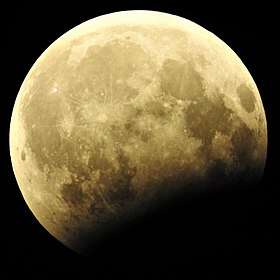Total penumbral lunar eclipse
A total penumbral lunar eclipse is a lunar eclipse that occurs when the Moon becomes completely immersed in the penumbral cone of the Earth without touching the umbra.[1]
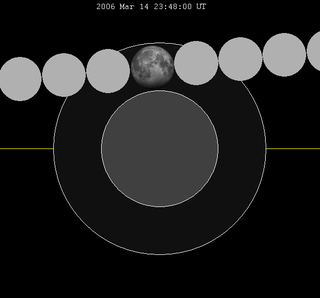
The path for the Moon to pass within the penumbra and outside the umbra is very narrow. It can only happen on the Earth's northern or southern penumbral edges. In addition, the size of the penumbra is sometimes too small where the Moon enters it to contain the Moon. The width of the Earth's penumbra is determined by the Sun's angular diameter at the time of the eclipse, and the Moon's angular diameter is larger than the Sun over part of its elliptical orbit, depending on whether the eclipse occurs at the nearest (perigee) or farthest point (apogee) in its orbit around the Earth. The majority of the time, the size of the Moon and the size of the Earth's penumbra where the Moon crosses it mean that most eclipses will not be total penumbral in nature.
Frequency
Total penumbral eclipses constitute a relatively small fraction of lunar eclipses, and the distribution of these events is uneven, occurring between 0 and 9 times per century. The period of this variation is approximately 600 years and also correlates with the frequency of total umbral eclipses and tetrads.[1]
The maximum number in Fred's 5K canon[N 1] is eight for saros 19.[2] Saros 32 and 132 have seven.[3][4] Saros 58, 95, and 114 have six.[5][6][7]
Saros 114 is the only saros in the canon to have a total of seven total penumbral lunar eclipses that are not all in a row.[7] Likewise, saros 169 has five total penumbral eclipses, but only four of them occur consecutively.[8]
Saros series with multiple consecutive total penumbral eclipses
This table summarizes which saros series contain four or more consecutive total penumbral eclipses.
| Sarosseries | Consecutive totalpenumbral eclipses |
|---|---|
| -339 | 7[9] |
| -266 | 13[9] |
| -258 | 9[9] |
| -247 | 10[9] |
| -237 | 10[9] |
| -226 | 10[9] |
| -218 | 12[9] |
| -157 | 6[9] |
| -118 | 4[9] |
| -116 | 7[9] |
| -105 | 11[9] |
| -39 | 9[9] |
| -37 | 6[9] |
| -26 | 9[9] |
| 19[N 1] | 8[2] |
| 32[N 1] | 7[3] |
| 58[N 1] | 6[5] |
| 95[N 1] | 6[6] |
| 114[N 1][N 2] | 6[7] |
| 132[N 1] | 7[4] |
| 169[N 1][N 3] | 4[8] |
| 187 | 5[9] |
| 255 | 4[9] |
Summary frequency of total penumbral, total umbral and tetrad events 501–2500

| Century | Totalpenumbral | Totalumbral | Tetrads |
|---|---|---|---|
| 501–600 | 1 | 63 | 0 |
| 601–700 | 2 | 58 | 0 |
| 701–800 | 2 | 69 | 3 |
| 801–900 | 5 | 88 | 8 |
| 901–1000 | 3 | 78 | 6 |
| 1001–1100 | 3 | 62 | 0 |
| 1101–1200 | 0 | 60 | 0 |
| 1201–1300 | 1 | 60 | 0 |
| 1301–1400 | 8 | 77 | 6 |
| 1401–1500 | 4 | 83 | 4 |
| 1501–1600 | 2 | 76 | 6 |
| 1601–1700 | 2 | 61 | 0 |
| 1701–1800 | 0 | 60 | 0 |
| 1801–1900 | 2 | 62 | 0 |
| 1901–2000 | 9 | 81 | 5 |
| 2001–2100 | 5 | 84 | 7 |
| 2101–2200 | 5 | 69 | 4 |
| 2201–2300 | 1 | 61 | 0 |
| 2301–2400 | 0 | 60 | 0 |
| 2401–2500 | 6 | 69 | 4 |
List of total penumbral lunar eclipse events 1901–2100
| Ascending nodes | Descending nodes | ||||||
|---|---|---|---|---|---|---|---|
| Saros | Date | Viewing | Chart | Saros | Date | Viewing | Chart |
| 110 | 1901 May 03 |  |  | ||||
| 114 | 1908 Dec 07 |  |  | ||||
| 114 | 1926 Dec 19 |  |  | ||||
| 114 | 1944 Dec 29 | 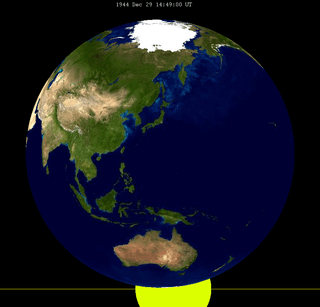 | 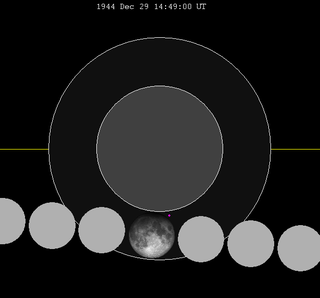 | ||||
| 116 | 1948 Oct 18 | 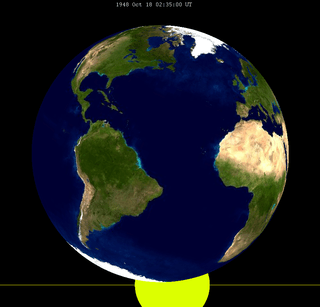 |  | ||||
| 114 | 1963 Jan 09 | 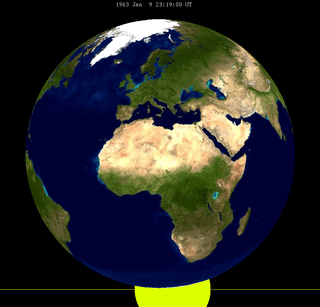 | 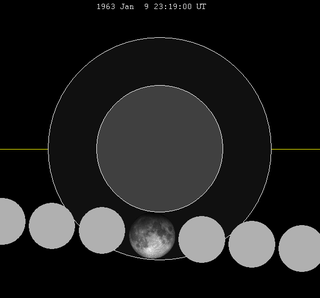 | ||||
| 114 | 1981 Jan 20 | 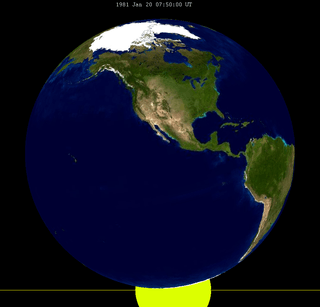 |  |
113 | 1988 Mar 03 | 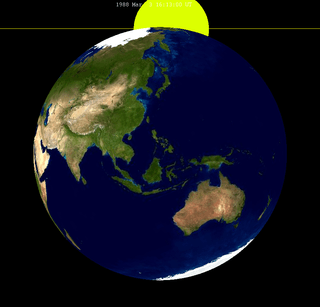 |  |
| 114 | 1999 Jan 31 | 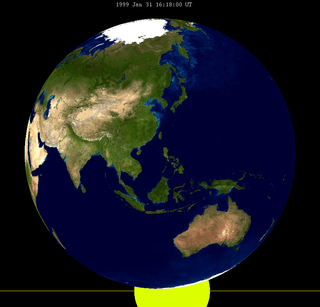 |  |
113 | 2006 Mar 14 | 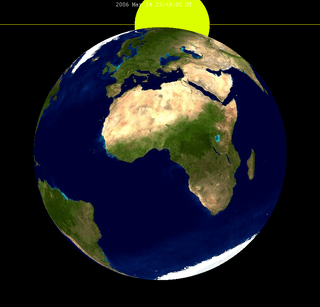 |  |
| 119 | 2053 Aug 29 |  | |||||
| 142 | 2070 Apr 25 |  |  | ||||
| 120 | 2082 Aug 08 |  |  | ||||
| 148 | 2099 Sep 29 |  |  |
||||
See also
Notes
- Total penumbral lunar eclipses are indicated by the Nx eclipse type in Fred Espenak's Lunar Eclipse canon.
- Saros 114 has seven total penumbral eclipses, but only six of them occur consecutively.
- Saros 169 has five total penumbral eclipses, but only four of them occur consecutively.
References
- "Total Penumbral lunar eclipses, Jean Meeus, 1980" (PDF).
- "NASA - Catalog of Lunar Eclipses in Saros 19". eclipse.gsfc.nasa.gov.
- "NASA - Catalog of Lunar Eclipses in Saros 32". eclipse.gsfc.nasa.gov.
- "NASA - Catalog of Lunar Eclipses in Saros 132". eclipse.gsfc.nasa.gov.
- "NASA - Catalog of Lunar Eclipses in Saros 58". eclipse.gsfc.nasa.gov.
- "NASA - Catalog of Lunar Eclipses in Saros 95". eclipse.gsfc.nasa.gov.
- "NASA - Catalog of Lunar Eclipses in Saros 114". eclipse.gsfc.nasa.gov.
- "NASA - Catalog of Lunar Eclipses in Saros 169". eclipse.gsfc.nasa.gov.
- John Irwin (2017). "Consecutive penumbral total lunar eclipses". Archived from the original (PNG) on 2017-02-25. Retrieved 2018-09-08. The dot color indicates the sign (positive/negative) of the eclipse gamma.
